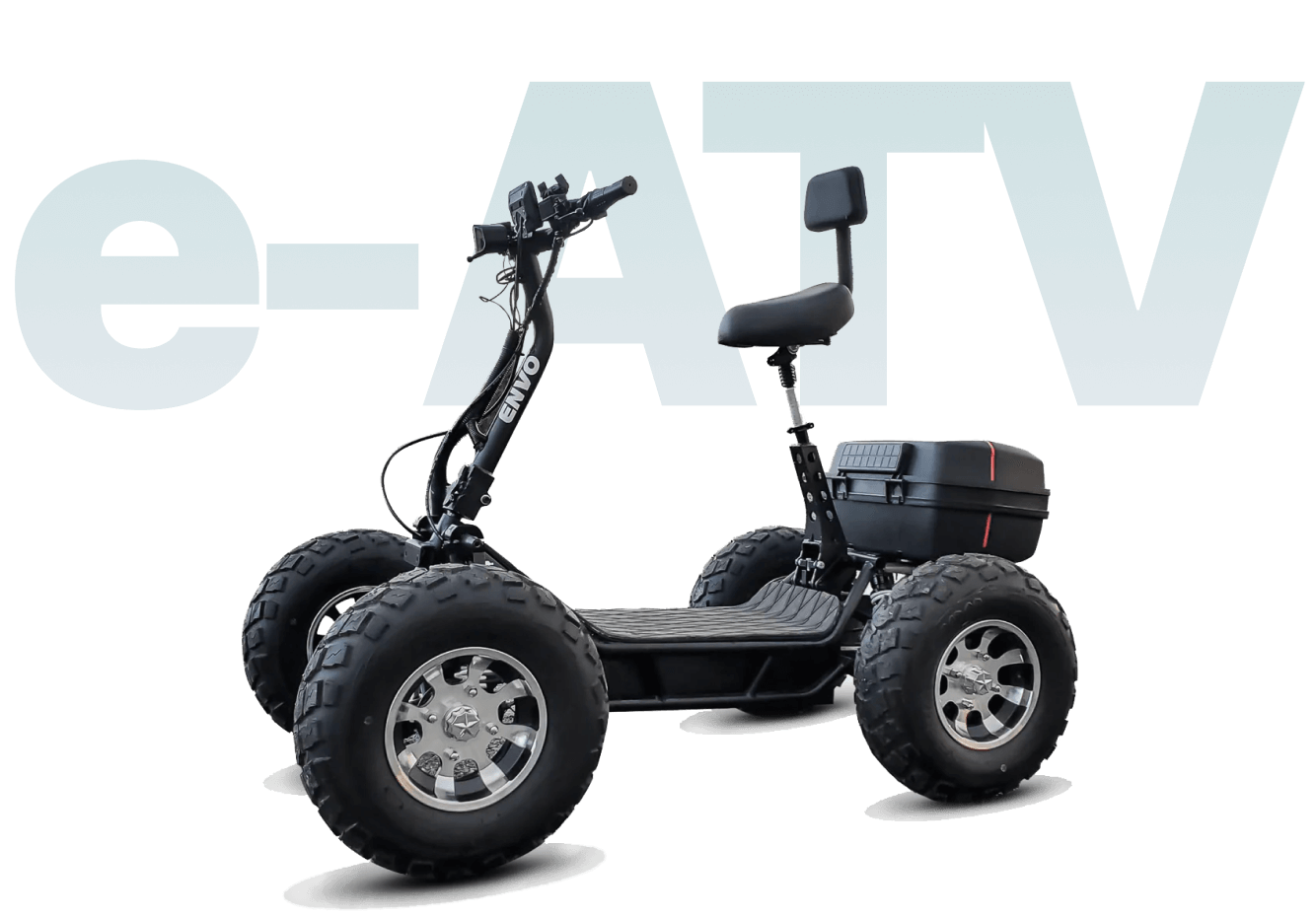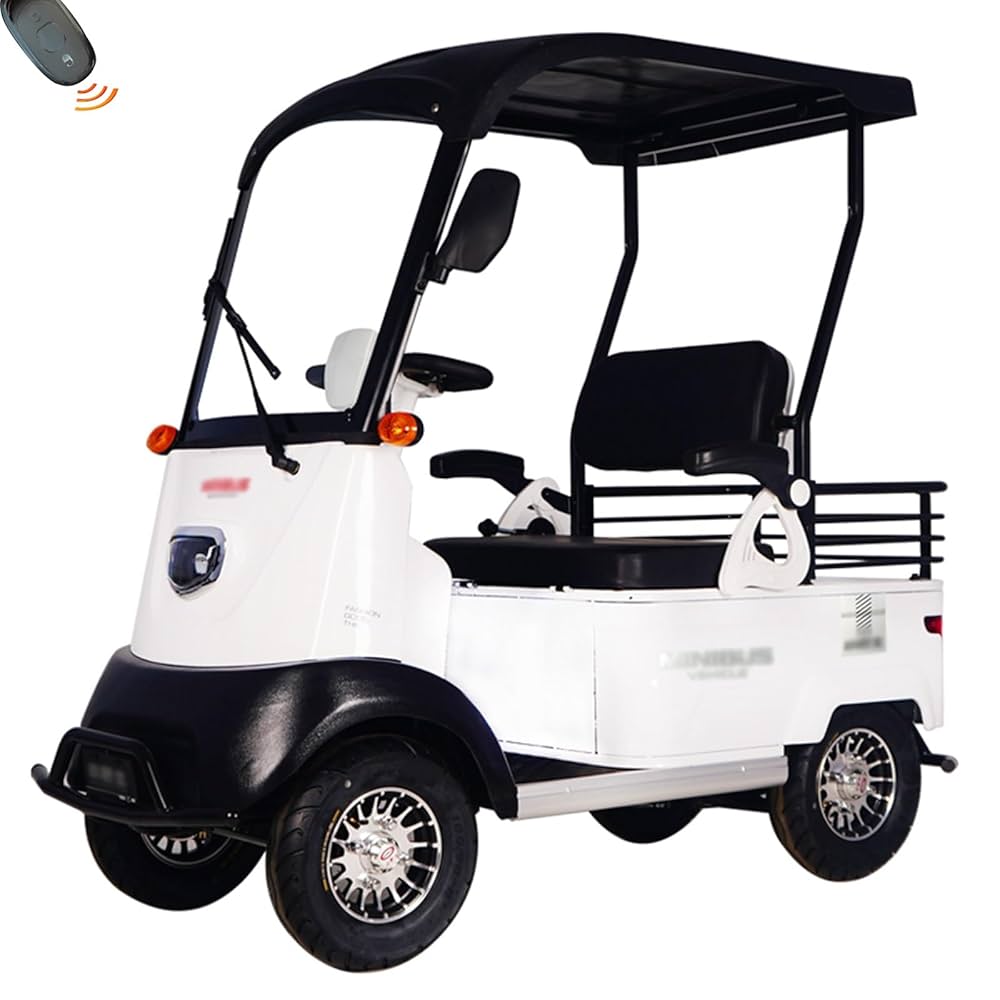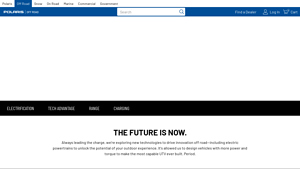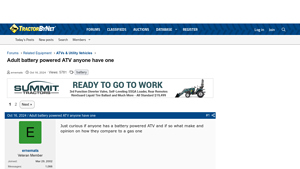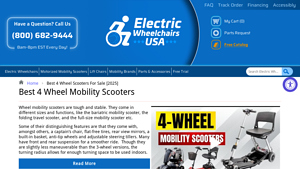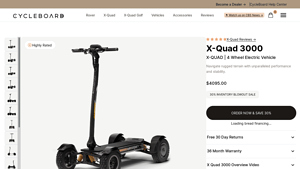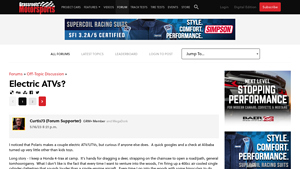Introduction: Navigating the Global Market for electric vehicles for adults 4 wheel
In today’s rapidly evolving automotive landscape, sourcing electric vehicles for adults with four-wheel capabilities presents unique challenges for international B2B buyers. As markets across Africa, South America, the Middle East, and Europe (including key players like Brazil and Saudi Arabia) increasingly prioritize sustainability and innovation, understanding the nuances of this emerging sector is crucial. This comprehensive guide delves into the diverse types of electric four-wheel vehicles available, their applications in various industries, and essential criteria for supplier vetting.
Buyers will benefit from insights into cost structures, performance metrics, and the latest technological advancements, including battery efficiency and charging solutions. The goal is to empower decision-makers with the knowledge needed to make informed purchasing choices that align with their operational needs and sustainability goals.
By navigating the complexities of the electric vehicle market, businesses can capitalize on opportunities that not only enhance their fleet’s capabilities but also contribute to a greener future. This guide serves as a vital resource for B2B buyers looking to leverage the potential of electric four-wheel vehicles, ensuring they are equipped with the necessary tools and insights to thrive in an increasingly competitive global market.
Understanding electric vehicles for adults 4 wheel Types and Variations
| Type Name | Key Distinguishing Features | Primary B2B Applications | Brief Pros & Cons for Buyers |
|---|---|---|---|
| All-Wheel Drive SUVs | Enhanced traction, suitable for varied terrains | Fleet vehicles, outdoor tourism, logistics | Pros: Better handling in adverse conditions; Cons: May have reduced range compared to 2WD. |
| Off-Road Electric Vehicles | High ground clearance, rugged design, off-road capability | Adventure tourism, agriculture, mining | Pros: Superior off-road performance; Cons: Higher initial cost, limited models available. |
| Electric Utility Vehicles | Designed for work applications, high payload capacity | Construction, landscaping, maintenance | Pros: Lower maintenance costs; Cons: Limited range for heavy-duty tasks. |
| Electric Sedans | Stylish design, typically lower range and cost | Corporate fleets, ridesharing services | Pros: Cost-effective for urban use; Cons: Limited off-road capabilities. |
| Electric Pickup Trucks | Versatile, high towing capacity, rugged design | Logistics, agriculture, outdoor services | Pros: Excellent hauling capabilities; Cons: Higher price point and weight may affect range. |
What are the characteristics and suitability of All-Wheel Drive SUVs for B2B buyers?
All-Wheel Drive (AWD) SUVs are designed for enhanced traction and stability, making them ideal for navigating various terrains and weather conditions. These vehicles are particularly suitable for businesses that require reliable transportation in rural or challenging environments, such as outdoor tourism, logistics, and fleet operations. B2B buyers should consider factors such as the balance between range and off-road capability, as AWD variants may experience a slight reduction in range compared to their two-wheel drive counterparts.
How do Off-Road Electric Vehicles meet the needs of specialized industries?
Off-road electric vehicles are characterized by their high ground clearance, rugged construction, and ability to handle challenging landscapes. They are particularly beneficial for industries like agriculture, mining, and adventure tourism, where traversing rough terrains is essential. B2B buyers should evaluate the vehicle’s off-road capabilities, battery life, and total cost of ownership, as these vehicles often come with a higher initial investment but can deliver significant performance benefits in demanding applications.
What advantages do Electric Utility Vehicles offer for commercial use?
Electric utility vehicles are specifically designed for work-related tasks, featuring high payload capacities and robust designs. They are commonly used in construction, landscaping, and maintenance operations. The primary advantages include lower maintenance costs and reduced environmental impact. However, B2B buyers must assess the vehicle’s range and charging infrastructure, particularly for applications that require extended operational hours or heavy loads, as these factors can influence overall efficiency.
Why might Electric Sedans be a preferred choice for corporate fleets?
Electric sedans provide a stylish and cost-effective solution for corporate fleets and ridesharing services, particularly in urban settings. They typically offer lower operating costs and emissions, making them an attractive option for businesses focused on sustainability. However, buyers should be aware of their limited off-road capabilities and range, which can be a concern for companies needing versatile transportation options. Evaluating the total cost of ownership and potential incentives for electric vehicle purchases can help in the decision-making process.
How do Electric Pickup Trucks cater to logistics and agriculture?
Electric pickup trucks are designed with versatility and high towing capacities, making them suitable for logistics, agriculture, and outdoor service industries. These vehicles combine rugged design with electric powertrains, providing excellent hauling capabilities while minimizing operating costs. B2B buyers should consider the price point, as electric pickups can be more expensive than traditional models, and assess their range capabilities to ensure they meet operational needs. The growing availability of charging infrastructure is also an important factor for businesses looking to transition to electric pickups.
Key Industrial Applications of electric vehicles for adults 4 wheel
| Industry/Sector | Specific Application of electric vehicles for adults 4 wheel | Value/Benefit for the Business | Key Sourcing Considerations for this Application |
|---|---|---|---|
| Agriculture | Utility transport for farms | Reduces fuel costs, supports sustainable practices, and enhances mobility across large terrains. | Consider battery capacity for long work hours and terrain adaptability. |
| Construction and Mining | On-site transportation of workers and materials | Improves efficiency with lower operational costs and reduced emissions. | Evaluate payload capacity, charging infrastructure, and off-road capabilities. |
| Tourism and Hospitality | Guest transportation in resorts and parks | Enhances guest experience with quiet, eco-friendly transport options. | Focus on durability, charging solutions, and aesthetic appeal. |
| Logistics and Delivery | Last-mile delivery vehicles | Provides cost-effective, green solutions for urban delivery challenges. | Assess range, load capacity, and compatibility with urban infrastructure. |
| Emergency Services | Rapid response vehicles for medical and disaster relief | Offers quick, silent operation in sensitive environments. | Ensure reliability, range, and readiness for diverse terrains. |
How Can Electric Vehicles Transform Agriculture and Farming Operations?
In the agricultural sector, electric vehicles (EVs) for adults can serve as utility transport on farms, facilitating the movement of equipment, supplies, and personnel across expansive properties. Their electric powertrains reduce fuel costs significantly and support sustainable practices, which are increasingly crucial for compliance with environmental regulations. Buyers in this sector should prioritize battery capacity and vehicle adaptability to handle various terrains, ensuring operational efficiency during long working hours.
What Are the Benefits of Electric Vehicles in Construction and Mining Industries?
For construction and mining operations, electric vehicles can be utilized for on-site transportation of workers and materials. These vehicles enhance operational efficiency by minimizing fuel costs and lowering emissions, aligning with growing regulatory pressures for sustainability. B2B buyers in these industries should consider the payload capacity and charging infrastructure available on-site, as well as the vehicle’s off-road capabilities to navigate rugged terrains effectively.
How Do Electric Vehicles Enhance Guest Experiences in Tourism and Hospitality?
In the tourism and hospitality industry, electric vehicles can be employed for guest transportation within resorts and parks. Their quiet and eco-friendly operation enhances the overall guest experience, promoting a peaceful environment that aligns with nature-focused tourism. Buyers in this sector should focus on the durability and aesthetic appeal of the vehicles, as well as the availability of efficient charging solutions to ensure seamless service.
What Role Do Electric Vehicles Play in Logistics and Urban Delivery Services?
Electric vehicles are transforming logistics and delivery services, particularly for last-mile delivery in urban areas. They offer a cost-effective and environmentally friendly solution to the challenges of urban delivery, such as traffic congestion and emission regulations. B2B buyers should assess the range and load capacity of these vehicles, ensuring compatibility with existing urban infrastructure to maximize efficiency and service effectiveness.
How Are Electric Vehicles Beneficial for Emergency Services?
In emergency services, electric vehicles provide rapid response capabilities for medical and disaster relief operations. Their silent operation is particularly advantageous in sensitive environments, allowing for discreet and efficient service delivery. Buyers in this sector must ensure that the vehicles are reliable and capable of traversing diverse terrains, with adequate range to respond swiftly to emergencies.
3 Common User Pain Points for ‘electric vehicles for adults 4 wheel’ & Their Solutions
Scenario 1: Limited Range and Charging Infrastructure Hurdles
The Problem: B2B buyers often face the challenge of electric vehicles (EVs) having limited range, particularly in regions with underdeveloped charging infrastructure. This is especially relevant for businesses operating in rural or remote areas in regions like Africa or South America, where charging stations may be scarce. This limitation can lead to operational disruptions, increased downtime, and difficulties in planning logistics and fleet management.
The Solution: To mitigate range anxiety, businesses should conduct a thorough analysis of their operational routes and the geographical areas they serve. Buyers can opt for electric vehicles with longer ranges—ideally over 300 miles—such as the Nissan Ariya or Skoda Enyaq. Additionally, consider implementing a network of charging stations at strategic locations within your service area. Collaborating with local governments or energy providers to establish charging infrastructure can not only benefit your fleet but also enhance local community resources. Furthermore, investing in vehicles equipped with advanced battery technology, which supports rapid charging capabilities, will allow for quicker turnaround times during operations.
Scenario 2: Weather and Terrain Adaptability Concerns
The Problem: Businesses that rely on electric vehicles for various terrains and weather conditions may struggle with the limited off-road capabilities of many EVs. For instance, companies operating in hilly or muddy terrains may find that standard electric SUVs cannot handle adverse conditions, leading to potential service delays and vehicle damage.
The Solution: When selecting electric vehicles, it is crucial to prioritize models that are designed for all-terrain capabilities. B2B buyers should look for vehicles that feature advanced all-wheel-drive systems and adequate ground clearance, such as the Mercedes G-Class EQ or the Subaru Solterra. It is also beneficial to conduct field tests in diverse weather and terrain conditions to assess the vehicles’ performance before committing to a purchase. By doing so, companies can ensure that the vehicles will meet the operational demands and provide reliable service, even in challenging conditions. Additionally, consider investing in training for drivers on how to optimize vehicle performance in various environments, enhancing overall safety and efficiency.
Scenario 3: Maintenance and Operational Cost Misconceptions
The Problem: Many B2B buyers harbor misconceptions about the maintenance costs associated with electric vehicles, often fearing that they may incur unforeseen expenses. This concern can be particularly pronounced in markets where traditional vehicle servicing is more familiar and perceived as less costly.
The Solution: To combat this issue, buyers should perform a detailed total cost of ownership analysis that encompasses maintenance, fuel savings, and potential tax incentives for electric vehicle adoption. Highlight the lower maintenance needs of electric vehicles, such as no oil changes or fuel filters, which can significantly reduce long-term costs. B2B buyers can also partner with manufacturers that offer comprehensive maintenance plans or warranties to ensure predictable costs over time. Educating stakeholders within the organization about the benefits of EVs, including reduced operational costs and environmental impact, will help to build confidence in the transition. Furthermore, leveraging telematics and fleet management software can optimize vehicle usage and maintenance schedules, further driving down costs and enhancing operational efficiency.
Strategic Material Selection Guide for electric vehicles for adults 4 wheel
What Are the Key Materials for Electric Vehicles for Adults 4 Wheel?
When selecting materials for electric vehicles (EVs) designed for adults, particularly four-wheel models, it is crucial to consider various materials that can enhance performance, durability, and overall vehicle efficiency. Below, we analyze four common materials used in the manufacture of electric vehicles, focusing on their properties, advantages, disadvantages, and implications for international B2B buyers.
How Do Aluminum Alloys Impact Electric Vehicle Performance?
Aluminum alloys are increasingly favored in the automotive industry due to their lightweight nature and excellent corrosion resistance. They typically have a temperature rating of up to 600°F and can withstand moderate pressure, making them suitable for various components, including chassis and body panels.
Pros: Aluminum is durable, lightweight, and offers good thermal conductivity, which is beneficial for battery cooling systems. Its recyclability also appeals to environmentally conscious manufacturers.
Cons: The primary drawback is the higher cost compared to steel, along with increased manufacturing complexity, especially in welding and joining processes.
Impact on Application: Aluminum’s lightweight properties directly enhance vehicle range and efficiency, crucial for EV performance. However, it requires careful consideration of joining techniques to maintain structural integrity.
Considerations for International Buyers: Compliance with international standards such as ASTM and DIN is essential, particularly regarding corrosion resistance in humid climates found in regions like Brazil and Saudi Arabia.
What Role Does Steel Play in Electric Vehicle Manufacturing?
Steel remains a staple material in automotive manufacturing due to its strength and cost-effectiveness. It can handle high pressures and temperatures, making it suitable for structural components and safety features.
Pros: Steel is highly durable and offers excellent crash safety performance. It is also more affordable than aluminum, making it a preferred choice for budget-conscious manufacturers.
Cons: The weight of steel can negatively impact the overall efficiency of electric vehicles, reducing range. Additionally, it is prone to corrosion without proper coatings.
Impact on Application: Steel’s strength makes it ideal for safety-critical components, but its weight can limit performance in electric vehicles, necessitating a balance between safety and efficiency.
Considerations for International Buyers: Buyers should be aware of the various steel grades and their compliance with local standards, particularly in regions with strict regulations on vehicle safety and emissions.
How Does Composite Material Enhance Electric Vehicle Design?
Composite materials, including carbon fiber and fiberglass, are gaining traction in EV manufacturing due to their exceptional strength-to-weight ratio and corrosion resistance.
Pros: Composites are lightweight, which can significantly improve vehicle range and performance. They also offer design flexibility and can be molded into complex shapes.
Cons: The primary limitation is the high cost of production and the complexity of manufacturing processes. Repairing composite materials can also be more challenging than metals.
Impact on Application: The use of composites can enhance aesthetic appeal and performance, particularly in high-end models. However, the cost may limit their application in mass-market vehicles.
Considerations for International Buyers: Buyers need to ensure compliance with international standards for composite materials, especially in markets where durability and repairability are critical concerns.
What Are the Benefits of Lithium-Ion Batteries in Electric Vehicles?
Lithium-ion batteries are the backbone of electric vehicle powertrains, offering high energy density and efficiency. They can operate effectively across a wide temperature range and are relatively lightweight.
Pros: These batteries provide excellent energy storage capabilities, allowing for longer driving ranges. They also have a lower self-discharge rate compared to other battery types.
Cons: The main disadvantages include high costs and potential safety concerns related to thermal runaway. Additionally, sourcing raw materials like lithium can be challenging due to geopolitical factors.
Impact on Application: The choice of lithium-ion batteries directly affects the vehicle’s range and charging capabilities, making them essential for consumer acceptance and market competitiveness.
Considerations for International Buyers: Compliance with international safety standards is crucial, particularly in regions with stringent regulations on battery performance and recycling.
Summary Table of Material Selection for Electric Vehicles
| Material | Typical Use Case for electric vehicles for adults 4 wheel | Key Advantage | Key Disadvantage/Limitation | Relative Cost (Low/Med/High) |
|---|---|---|---|---|
| Aluminum Alloys | Chassis and body panels | Lightweight and corrosion-resistant | Higher cost and manufacturing complexity | High |
| Steel | Structural components and safety features | Durable and cost-effective | Heavier weight affecting efficiency | Med |
| Composite Materials | Body panels and aesthetic components | High strength-to-weight ratio | High production cost and complex repairs | High |
| Lithium-Ion Batteries | Powertrains and energy storage | High energy density and efficiency | High cost and safety concerns | High |
This strategic material selection guide provides B2B buyers with valuable insights into the materials used in electric vehicles for adults, enabling informed decisions that align with performance, cost, and compliance considerations across diverse international markets.
In-depth Look: Manufacturing Processes and Quality Assurance for electric vehicles for adults 4 wheel
What Are the Main Stages in the Manufacturing Process of Electric Vehicles for Adults?
The manufacturing process of electric vehicles (EVs) for adults, particularly four-wheel models, involves several key stages: material preparation, forming, assembly, and finishing. Each stage is crucial for ensuring the final product meets the desired performance, safety, and quality standards.
How Is Material Prepared for Electric Vehicle Manufacturing?
Material preparation begins with sourcing high-quality raw materials, including metals, plastics, and lithium-ion batteries. Suppliers must adhere to stringent international standards for quality to ensure durability and performance. For instance, aluminum is often used for vehicle chassis due to its lightweight properties, while high-strength steel is utilized for structural components. The materials undergo thorough inspections to verify compliance with specifications before they proceed to the forming stage.
What Techniques Are Used in Forming Electric Vehicles?
The forming stage typically involves advanced techniques such as stamping, extrusion, and molding. Stamping is commonly used to create body panels and structural components, while extrusion is applied for producing long, continuous shapes like battery enclosures. Molding techniques are employed for producing plastic parts, including dashboards and interior components. Automation plays a significant role in this stage, with robotic systems enhancing precision and efficiency.
How Is the Assembly Process Structured for Electric Vehicles?
The assembly of electric vehicles is a highly coordinated process. Components are brought together on an assembly line, where workers or robots install parts in a systematic order. Key components include the electric motor, battery pack, drivetrain, and electronic control units. Quality checks are integrated throughout the assembly line to ensure that each component fits correctly and functions as intended. The use of modular designs allows for easier upgrades and replacements in the future.
What Finishing Techniques Are Applied to Electric Vehicles?
Finishing involves several processes, including painting, surface treatment, and final assembly checks. The painting process not only enhances aesthetics but also provides protective coatings against corrosion and wear. Additionally, surface treatments may include anodizing or galvanization to improve material durability. Final assembly checks ensure that all systems are operational, and any discrepancies are addressed before the vehicle is dispatched.
What Quality Assurance Standards Are Relevant for Electric Vehicles?
Quality assurance (QA) in the manufacturing of electric vehicles is vital to ensure safety, reliability, and customer satisfaction. International standards such as ISO 9001 provide a framework for establishing a quality management system, ensuring that processes meet customer and regulatory requirements. Furthermore, industry-specific certifications like CE (Conformité Européenne) for European markets and API (American Petroleum Institute) standards for components are critical for compliance.
What Are the Key Quality Control Checkpoints in EV Manufacturing?
Quality control (QC) checkpoints are integral to maintaining high standards throughout the manufacturing process. These checkpoints include:
- Incoming Quality Control (IQC): This initial stage involves inspecting raw materials and components upon arrival to ensure they meet specified standards.
- In-Process Quality Control (IPQC): Continuous monitoring occurs during the manufacturing process to catch defects early and prevent them from progressing further down the line.
- Final Quality Control (FQC): This last stage involves comprehensive testing and inspection of the finished vehicle to confirm that it meets all design specifications and safety standards.
Common testing methods include functional testing, performance testing, and safety assessments. For instance, electric vehicles undergo rigorous battery performance tests to assess range, charging speed, and thermal management.
How Can B2B Buyers Verify Supplier Quality Control Practices?
For international B2B buyers, verifying a supplier’s quality control practices is crucial to ensure product reliability and compliance with standards. Here are several methods to achieve this:
-
Audits: Conducting regular audits of potential suppliers can help assess their adherence to quality management systems and manufacturing practices. This includes reviewing documentation, processes, and facilities.
-
Quality Reports: Requesting detailed quality reports from suppliers can provide insight into their QC processes, including defect rates, corrective actions taken, and compliance with international standards.
-
Third-Party Inspections: Engaging third-party inspection agencies can offer an unbiased evaluation of a supplier’s manufacturing processes and product quality. These agencies can perform inspections at various stages of production and provide certifications.
What Are the Quality Control Nuances for B2B Buyers in Different Regions?
B2B buyers from regions like Africa, South America, the Middle East, and Europe must be aware of specific quality control nuances that can affect their purchasing decisions. For instance:
-
Regulatory Compliance: Different regions have varying regulatory requirements for electric vehicles. Buyers should ensure that suppliers can meet these local regulations, which may include environmental standards, safety certifications, and import/export compliance.
-
Supply Chain Challenges: Some regions may face unique supply chain challenges, such as delays in material sourcing or transportation. Buyers should assess a supplier’s ability to manage these challenges to avoid disruptions.
-
Cultural Considerations: Understanding cultural differences in business practices can also aid in forming successful partnerships. Open communication and regular engagement can help bridge any gaps.
In conclusion, the manufacturing processes and quality assurance for electric vehicles for adults involve a complex interplay of advanced techniques and stringent standards. B2B buyers must navigate these intricacies to ensure they partner with reliable suppliers capable of delivering high-quality products that meet international standards. By implementing thorough verification methods and understanding regional nuances, buyers can make informed decisions that enhance their operational success.
Practical Sourcing Guide: A Step-by-Step Checklist for ‘electric vehicles for adults 4 wheel’
Introduction
This guide provides a comprehensive checklist for B2B buyers looking to procure electric vehicles (EVs) for adults with four-wheel drive capabilities. As the market for electric vehicles expands, especially in regions such as Africa, South America, the Middle East, and Europe, understanding the nuances of sourcing these vehicles is crucial for making informed purchasing decisions.
Step 1: Define Your Technical Specifications
Establishing clear technical specifications is the foundation of your procurement process. Consider factors such as range, charging speed, and off-road capabilities. For instance, if your operations involve rural areas, prioritize models that offer enhanced ground clearance and all-wheel drive for improved traction on slippery surfaces.
Step 2: Research Market Trends and Innovations
Staying informed about the latest trends in electric vehicles can give you a competitive edge. Look for emerging technologies such as advanced battery systems and regenerative braking that enhance efficiency and performance. Understanding these innovations can help you identify vehicles that not only meet current needs but are also future-proof.
Step 3: Evaluate Potential Suppliers
Thoroughly vetting suppliers is essential before making any commitments. Request detailed company profiles, product specifications, and customer testimonials from businesses in similar sectors. This will help ensure that your chosen supplier has a proven track record and can meet your specific requirements.
- Check for certifications: Ensure that suppliers have relevant certifications that adhere to international standards, which can indicate product quality and reliability.
- Assess after-sales support: Reliable after-sales service is crucial for maintaining vehicle performance, especially in remote areas.
Step 4: Conduct Cost-Benefit Analysis
Perform a thorough cost-benefit analysis to evaluate the total cost of ownership, not just the initial purchase price. Consider factors such as maintenance costs, fuel savings from electric powertrains, and potential government incentives for electric vehicle purchases. A comprehensive analysis will help you understand the long-term financial implications of your investment.
Step 5: Request Test Drives and Demonstrations
Before finalizing any purchase, arrange for test drives or demonstrations of the vehicles you are considering. This hands-on experience will provide valuable insights into the vehicle’s performance, comfort, and suitability for your specific needs. Pay attention to aspects like handling, acceleration, and off-road capabilities.
Step 6: Verify Warranty and Support Terms
Review the warranty and support terms offered by the supplier. A robust warranty can significantly reduce future costs related to repairs and maintenance. Additionally, ensure that the supplier provides adequate support for charging infrastructure, which is essential for the operational efficiency of electric vehicles.
Step 7: Finalize Contractual Agreements
Once you have selected your preferred supplier and vehicle, ensure that all contractual terms are clear and agreed upon. Pay close attention to delivery timelines, payment terms, and any service level agreements. This step is vital to prevent misunderstandings and ensure a smooth procurement process.
By following this checklist, B2B buyers can effectively navigate the complexities of sourcing electric vehicles for adults with four-wheel drive capabilities, ensuring that they make informed and strategic purchasing decisions.
Comprehensive Cost and Pricing Analysis for electric vehicles for adults 4 wheel Sourcing
What Are the Key Cost Components of Electric Vehicles for Adults 4 Wheel?
When sourcing electric vehicles (EVs) for adults, especially those with four-wheel capabilities, it’s essential to understand the various cost components involved in the manufacturing and procurement processes. These components typically include:
-
Materials: The cost of raw materials, such as lithium-ion batteries, aluminum for the body, and specialized electrical components, significantly influences the overall price. The fluctuating prices of these materials can impact the final cost of the vehicle.
-
Labor: Labor costs can vary widely based on location and the skill level required for assembly and manufacturing. Countries with lower labor costs may provide a competitive advantage, but this can also affect quality and compliance with international standards.
-
Manufacturing Overhead: This includes costs related to factory operations, utilities, equipment depreciation, and indirect labor. Efficient manufacturing processes can help reduce these overheads, making the vehicles more competitively priced.
-
Tooling: Initial setup costs for manufacturing tools and equipment can be substantial, especially for specialized components unique to electric vehicles. These costs are often amortized over the production run, which can affect pricing for smaller orders.
-
Quality Control (QC): Ensuring high standards through rigorous QC processes incurs additional costs. However, investing in quality can result in lower warranty claims and higher customer satisfaction, which are crucial for long-term success.
-
Logistics: Transportation and shipping costs, especially for international orders, can add significantly to the total cost. Factors such as distance, shipping method, and customs duties must be carefully considered.
-
Margin: Manufacturers typically add a profit margin to cover their costs and ensure sustainability. This margin can vary based on market competition and the perceived value of the vehicle.
How Do Price Influencers Affect the Sourcing of Electric Vehicles?
Several factors influence pricing when sourcing electric vehicles, particularly for international B2B buyers:
-
Volume/MOQ (Minimum Order Quantity): Bulk purchasing can lead to significant discounts. Negotiating favorable terms based on order size can reduce per-unit costs.
-
Specifications and Customization: Vehicles tailored to specific requirements or equipped with advanced technology may incur higher costs. Understanding the balance between necessary features and budget constraints is vital.
-
Materials and Quality Certifications: The choice of materials impacts both performance and price. High-quality materials and certifications (like ISO standards) can enhance vehicle reliability but may also increase costs.
-
Supplier Factors: The reputation and reliability of the supplier can affect pricing. Established suppliers may charge a premium for their proven quality and service, while newer entrants might offer lower prices to gain market share.
-
Incoterms: Understanding the terms of trade (e.g., FOB, CIF) is crucial for calculating total costs. This affects logistics responsibilities and risk allocation between buyers and sellers.
What Negotiation Tips Can Enhance Cost-Efficiency for Buyers?
For international B2B buyers, particularly those in regions like Africa, South America, the Middle East, and Europe, effective negotiation and cost-management strategies are essential:
-
Total Cost of Ownership (TCO): Evaluate the TCO rather than just the purchase price. Consider factors like maintenance, energy consumption, and resale value to make informed decisions.
-
Leverage Market Research: Understanding market trends and competitor pricing can provide leverage during negotiations. This knowledge can help in justifying requests for discounts or better payment terms.
-
Build Long-Term Relationships: Establishing strong relationships with suppliers can lead to more favorable terms, including better pricing and priority service in times of demand.
-
Explore Financing Options: Investigate financing arrangements or leasing options that can spread costs over time, making it easier to manage cash flow while acquiring high-quality vehicles.
-
Stay Informed About Regulatory Changes: Compliance with local regulations and incentives can affect pricing structures. Buyers should be aware of any government subsidies or tariffs that may influence costs.
Disclaimer on Indicative Prices
The prices mentioned in this analysis are indicative and can vary based on market conditions, supplier negotiations, and specific vehicle configurations. Always conduct thorough due diligence and seek tailored quotes for accurate pricing information.
Alternatives Analysis: Comparing electric vehicles for adults 4 wheel With Other Solutions
Understanding Alternatives to Electric Vehicles for Adults 4 Wheel
As the demand for sustainable transportation solutions grows, businesses are exploring various options for mobility. Electric vehicles (EVs) for adults with four-wheel capabilities are increasingly popular, but they are not the only choice. This analysis compares electric vehicles to alternative solutions, including traditional internal combustion engine (ICE) vehicles and hybrid vehicles. Each option presents unique advantages and challenges, making it essential for B2B buyers to consider their specific needs before making a decision.
Comparison Table
| Comparison Aspect | Electric Vehicles For Adults 4 Wheel | Traditional Internal Combustion Engine Vehicles | Hybrid Vehicles |
|---|---|---|---|
| Performance | High torque, instant acceleration | Moderate performance, reliant on engine power | Balanced performance, good acceleration |
| Cost | Higher initial investment, lower operating costs | Lower purchase price, fluctuating fuel costs | Moderate cost, better fuel efficiency than ICE |
| Ease of Implementation | Requires charging infrastructure | Established fuel infrastructure, easy access | Requires both fuel and charging infrastructure |
| Maintenance | Lower maintenance costs, fewer moving parts | Higher maintenance costs due to engine complexity | Moderate maintenance needs, engine and electric system upkeep |
| Best Use Case | Urban and off-road environments | Long-distance travel and rural areas | Mixed-use, city, and highway driving |
Detailed Breakdown of Alternatives
Traditional Internal Combustion Engine Vehicles
Traditional ICE vehicles have been the standard for decades, offering a wide range of models suited for various terrains and purposes. Their main advantage lies in their established infrastructure, making refueling convenient and accessible. However, they come with fluctuating fuel costs and higher maintenance expenses due to more complex engine systems. For businesses that prioritize immediate availability and lower upfront costs, ICE vehicles remain a viable option, especially in regions where charging stations for EVs are scarce.
Hybrid Vehicles
Hybrid vehicles combine an internal combustion engine with an electric motor, allowing for improved fuel efficiency and lower emissions compared to traditional ICE vehicles. They are particularly effective in urban settings where stop-and-go traffic benefits from electric propulsion. While hybrids offer a middle ground in terms of performance and fuel consumption, they still require both gasoline and charging infrastructure, which can complicate logistics. For businesses looking for flexibility and reduced fuel costs without fully committing to electric vehicles, hybrids can be an excellent solution.
Conclusion: Choosing the Right Solution for Your Business
Selecting the appropriate transportation solution involves evaluating your business’s specific operational needs, budget constraints, and environmental goals. Electric vehicles for adults with four-wheel capabilities offer innovative performance and lower operating costs, making them ideal for urban and off-road applications. In contrast, traditional ICE vehicles provide established infrastructure and immediate availability, while hybrid vehicles present a compromise between the two. By assessing the unique requirements of your operations and considering the advantages and disadvantages of each alternative, you can make an informed decision that aligns with your business objectives and sustainability initiatives.
Essential Technical Properties and Trade Terminology for electric vehicles for adults 4 wheel
What Are the Key Technical Properties of Electric Vehicles for Adults 4-Wheel?
When sourcing electric vehicles (EVs) for adults, particularly in B2B contexts, understanding critical technical specifications is essential. Here are some key properties to consider:
-
Battery Capacity (kWh)
– Definition: Measured in kilowatt-hours (kWh), battery capacity indicates the amount of energy the battery can store. A higher capacity translates to a longer driving range.
– B2B Importance: For international buyers, especially in regions with limited charging infrastructure, a higher battery capacity is crucial for ensuring vehicles can meet operational needs without frequent recharging. -
Range (Miles)
– Definition: The maximum distance a vehicle can travel on a single charge. It is influenced by battery capacity, vehicle weight, and driving conditions.
– B2B Importance: Understanding range helps businesses assess whether an EV can fulfill their logistics requirements, particularly in vast geographic areas typical in regions like Africa and South America. -
Charging Time (Hours)
– Definition: The time required to fully charge the vehicle’s battery. This varies significantly based on the charger type (e.g., Level 1, Level 2, DC fast charging).
– B2B Importance: Quick charging capabilities can significantly reduce downtime, making EVs more viable for businesses that rely on vehicle availability for operations. -
Torque (lb-ft)
– Definition: Torque measures the rotational force produced by the vehicle’s electric motor, crucial for acceleration and towing capacity.
– B2B Importance: For businesses needing to haul goods or navigate challenging terrains, high torque ratings can indicate a vehicle’s suitability for demanding tasks. -
Drive System (AWD vs. RWD)
– Definition: This refers to whether a vehicle has all-wheel drive (AWD) or rear-wheel drive (RWD). AWD provides power to all four wheels, enhancing traction and stability.
– B2B Importance: In regions with adverse weather conditions or rough terrains, AWD is often preferable, offering better handling and safety, which is vital for fleet operators. -
Warranty and Maintenance Terms
– Definition: This encompasses the duration and coverage of the manufacturer’s warranty, as well as expected maintenance intervals and costs.
– B2B Importance: A robust warranty can mitigate long-term operational risks, while lower maintenance costs can enhance the total cost of ownership.
What Are Common Trade Terms in the Electric Vehicle Industry?
Familiarity with industry jargon can facilitate smoother transactions and negotiations. Here are several essential terms:
-
OEM (Original Equipment Manufacturer)
– Definition: A company that produces parts or equipment that may be marketed by another manufacturer. In the EV context, it often refers to the vehicle manufacturer.
– Relevance: Understanding OEMs helps buyers identify quality sources for parts, ensuring compatibility and reliability in vehicle procurement. -
MOQ (Minimum Order Quantity)
– Definition: The smallest quantity of a product that a supplier is willing to sell.
– Relevance: Knowing the MOQ is crucial for B2B buyers to plan their procurement strategies effectively, especially in bulk purchasing scenarios. -
RFQ (Request for Quotation)
– Definition: A document sent to suppliers requesting pricing and terms for specific goods or services.
– Relevance: Issuing an RFQ can streamline the sourcing process, allowing businesses to compare offers and negotiate better deals. -
Incoterms (International Commercial Terms)
– Definition: A set of predefined international rules that clarify the responsibilities of buyers and sellers in global trade.
– Relevance: Familiarity with Incoterms ensures clarity in shipping responsibilities, costs, and risks, crucial for international transactions involving electric vehicles. -
Lifecycle Cost (LCC)
– Definition: The total cost of ownership over the life of an asset, including purchase price, operating costs, maintenance, and disposal.
– Relevance: LCC analysis helps businesses evaluate the long-term financial implications of investing in electric vehicles, ensuring informed decision-making. -
Regenerative Braking
– Definition: A technology that captures energy normally lost during braking and redirects it back into the battery.
– Relevance: Understanding this feature can help buyers appreciate the efficiency and range extension capabilities of electric vehicles, making them more attractive for sustainable operations.
By grasping these essential properties and terms, B2B buyers can make informed decisions when sourcing electric vehicles for adults, ensuring they align with their operational needs and market conditions.
Navigating Market Dynamics and Sourcing Trends in the electric vehicles for adults 4 wheel Sector
What Are the Key Drivers and Trends Shaping the Electric Vehicles for Adults 4-Wheel Market?
The electric vehicle (EV) market for adults, particularly in the four-wheel segment, is experiencing rapid growth, driven by several global factors. Firstly, the increasing demand for sustainable transportation solutions is propelling manufacturers to innovate and produce more electric models. Governments across Africa, South America, the Middle East, and Europe are implementing stricter emissions regulations and providing incentives for EV adoption, which creates a favorable environment for B2B buyers. Additionally, technological advancements in battery efficiency and charging infrastructure are enhancing the attractiveness of electric vehicles.
Notably, the trend towards all-wheel drive (AWD) electric vehicles is gaining traction, appealing to consumers looking for enhanced safety and performance in diverse driving conditions. This is particularly relevant for international markets with varying terrains, such as Brazil’s rugged landscapes and Saudi Arabia’s challenging desert routes. The availability of models that combine off-road capability with electric powertrains, like the upcoming all-electric Range Rover and Mercedes G-Class, is set to redefine market expectations. Furthermore, the rise of partnerships between traditional automotive manufacturers and tech firms is streamlining the supply chain and accelerating product development.
How Can B2B Buyers Prioritize Sustainability and Ethical Sourcing in Electric Vehicle Procurement?
Sustainability is a pivotal consideration for B2B buyers in the electric vehicle market. The environmental impact of sourcing materials and manufacturing processes is under scrutiny, making it essential for companies to prioritize ethical supply chains. This includes assessing the sourcing of raw materials such as lithium, cobalt, and nickel, which are critical for battery production. Buyers should seek manufacturers who are transparent about their sourcing practices and who prioritize fair labor standards and responsible environmental practices.
In addition to ethical sourcing, B2B buyers should look for certifications that validate the sustainability of their suppliers. Certifications such as ISO 14001 (Environmental Management) and initiatives like the Responsible Cobalt Initiative can provide assurance that suppliers are committed to reducing their environmental footprint. Moreover, investing in suppliers that utilize recycled materials or innovative, less harmful production processes can further enhance the sustainability profile of electric vehicle fleets. By aligning procurement strategies with sustainable practices, businesses can not only reduce their environmental impact but also enhance their brand reputation in an increasingly eco-conscious market.
What Is the Historical Context Behind the Electric Vehicles for Adults 4-Wheel Market?
The electric vehicle market has evolved significantly over the past few decades. Initially, electric vehicles were viewed as niche products with limited appeal due to high costs and inadequate infrastructure. However, advancements in battery technology and growing environmental awareness have shifted perceptions.
In the early 2000s, government incentives began to play a crucial role in promoting electric vehicles, particularly in Europe and North America. The introduction of models with improved range and performance helped to spark consumer interest. By the 2010s, major automotive manufacturers began investing heavily in electric technology, leading to a broader range of options for consumers. Today, electric vehicles for adults, especially in the four-wheel category, are not only a viable alternative to traditional combustion engines but are increasingly seen as essential for sustainable transportation solutions across diverse global markets. This historical context is vital for B2B buyers to understand the competitive landscape and anticipate future trends in the electric vehicle sector.
Frequently Asked Questions (FAQs) for B2B Buyers of electric vehicles for adults 4 wheel
-
How do I choose the right electric vehicle for my business needs?
When selecting an electric vehicle (EV) for your business, consider factors such as range, charging infrastructure, maintenance costs, and specific use cases. Evaluate the vehicle’s capabilities in terms of payload, off-road performance, and passenger capacity. It’s also crucial to assess the availability of service and support in your region. Conducting a cost-benefit analysis, including long-term savings from fuel and maintenance, can further guide your decision. Finally, consult with suppliers about customization options to ensure the vehicle meets your operational requirements. -
What is the best electric vehicle for off-road applications?
For off-road applications, vehicles like the Mercedes G580 with EQ technology or the upcoming all-electric Range Rover are top contenders due to their advanced all-wheel-drive systems and rugged capabilities. Look for features such as high ground clearance, robust suspension systems, and battery performance suited for challenging terrains. Additionally, consider vehicles with multiple driving modes to adapt to various conditions. Ensuring that the vehicle can handle the specific terrain and conditions relevant to your operations is essential for maximizing performance. -
What are the typical minimum order quantities (MOQs) for electric vehicles?
Minimum order quantities for electric vehicles can vary significantly based on the manufacturer and the specific model. Generally, MOQs range from a single unit for custom-built vehicles to larger quantities for standard models. For B2B buyers, it’s important to negotiate these terms with suppliers, as some manufacturers may offer flexibility based on your business needs or potential for future orders. Always clarify any associated costs and lead times with the supplier to avoid unexpected expenses. -
What payment terms should I expect when purchasing electric vehicles?
Payment terms for electric vehicles typically range from upfront payment to installment options, depending on the supplier’s policies. Some manufacturers may offer financing or leasing options that allow for lower initial costs and better cash flow management. It’s essential to discuss and negotiate payment structures that align with your budget and cash flow cycles. Additionally, consider any potential warranties or service agreements that may affect the total cost over time. -
How do I vet suppliers of electric vehicles for my business?
To effectively vet suppliers, start by researching their reputation in the industry, including customer reviews and case studies. Verify their manufacturing capabilities, certifications, and compliance with international standards. Engage in direct communication to assess their responsiveness and willingness to provide references. Request detailed product specifications, warranty information, and after-sales support options. Establishing a good rapport and understanding their logistical capabilities is also crucial for ensuring a reliable partnership. -
What are the logistics considerations for importing electric vehicles?
When importing electric vehicles, consider factors such as shipping methods, customs regulations, and local taxes. Engage with logistics partners experienced in handling vehicle imports to navigate these complexities. Ensure that all necessary documentation is prepared, including compliance certifications, import permits, and shipping invoices. Additionally, factor in delivery timelines and potential delays in customs clearance, as these can significantly impact your operations. -
What customization options are available for electric vehicles?
Customization options for electric vehicles can include modifications to the vehicle’s performance, aesthetics, and technology features. Depending on the manufacturer, you might request specific battery capacities, towing capabilities, or off-road enhancements. Interior customization, such as seating arrangements and technology integrations, can also be tailored to meet your business needs. Engaging with the supplier early in the process is key to understanding the available options and associated costs. -
What quality assurance measures should I consider when sourcing electric vehicles?
When sourcing electric vehicles, inquire about the supplier’s quality assurance processes, including testing protocols and certifications. Assess whether the vehicles undergo rigorous performance and safety evaluations before delivery. Understanding the warranty terms and after-sales support is crucial for long-term reliability. Additionally, consider suppliers that offer post-purchase training and maintenance services, as these can significantly enhance the operational efficiency and lifespan of the vehicles in your fleet.
Important Disclaimer & Terms of Use
⚠️ Important Disclaimer
The information provided in this guide, including content regarding manufacturers, technical specifications, and market analysis, is for informational and educational purposes only. It does not constitute professional procurement advice, financial advice, or legal advice.
While we have made every effort to ensure the accuracy and timeliness of the information, we are not responsible for any errors, omissions, or outdated information. Market conditions, company details, and technical standards are subject to change.
B2B buyers must conduct their own independent and thorough due diligence before making any purchasing decisions. This includes contacting suppliers directly, verifying certifications, requesting samples, and seeking professional consultation. The risk of relying on any information in this guide is borne solely by the reader.
Top 9 Electric Vehicles For Adults 4 Wheel Manufacturers & Suppliers List
1. Polaris – Key Off-Road Models
Domain: polaris.com
Registered: 1992 (33 years)
Introduction: {“models”:[{“name”:”2026 RANGER 1000″,”starting_price”:”$14,299″,”seating_options”:”3 Seat – 6 Seat”},{“name”:”2026 GENERAL XP 1000″,”starting_price”:”$23,999″,”seating_options”:”2 Seat – 4 Seat”},{“name”:”2025 RZR XP”,”starting_price”:”$19,999″,”seating_options”:”2 Seat – 4 Seat”},{“name”:”2026 SPORTSMAN 570″,”starting_price”:”$7,999″,”seating_options”:”1 Seat”},{“name”:”2025 RANGER XD 1500 NORTH…
2. DRR USA – Electric ATV
Domain: reddit.com
Registered: 2005 (20 years)
Introduction: 1. DRR USA Electric ATV – Price: $15,000, Range: 35 miles, Power: 7.5Kw (approximately 10hp). Concerns about dealer support and parts availability. 2. Eco Charger E-ATV – Mentioned but no specific details provided. 3. Powerland Tachyon – Mentioned but no specific details provided. 4. Chinese Electric ATVs – 4000w, 50ah, 4×4, top speed: 28-30 mph, utility use, snow plow capability, lead acid batter…
3. Subaru – Solterra & Mercedes – G 580 EQ
Domain: drivingelectric.com
Registered: 2009 (16 years)
Introduction: 1. Subaru Solterra: Prices from £52,495, Maximum WLTP combined range: 289 miles, Features: four-wheel drive, X-MODE for off-road driving, Grip Control, 150kW charging capability.
2. Mercedes G 580 with EQ Technology: Prices from £180,860, Maximum WLTP combined range: 285 miles, Power: 579bhp, Torque: 1,164Nm, 0-62mph in 4.7 seconds, 112kWh battery, 200kW peak charging speed.
3. Kia EV9: Prices fro…
4. Landmaster – AMP UTV
Domain: tractorbynet.com
Registered: 1999 (26 years)
Introduction: Battery powered side by side (UTV) – Landmaster “AMP”; features a lithium ion battery; 4WD (selectable) with a lockable rear differential; recommended not to use below 0°F and not to charge below freezing; stated range of 40 miles; good performance on steep hills; equipped with 4 wheel disc brakes and regenerative braking; made in the USA; designed for quieter operation compared to gas UTVs.
5. Electric Wheelchairs USA – Best 4 Wheel Mobility Scooters
Domain: electricwheelchairsusa.com
Registered: 2017 (8 years)
Introduction: Best 4 Wheel Mobility Scooters are tough and stable, available in various sizes and functions including bariatric, folding travel, and full-size scooters. Key features include captain’s chairs, flat-free tires, rear view mirrors, built-in baskets, anti-tip wheels, adjustable steering tillers, and front/rear suspension for a smoother ride. They are slightly less maneuverable than 3-wheel versions b…
6. AliExpress – Mini Electric Car for Adults
Domain: aliexpress.com
Registered: 2006 (19 years)
Introduction: This company, AliExpress – Mini Electric Car for Adults, is a notable entity in the market. For specific product details, it is recommended to visit their website directly.
7. Cycleboard – X-Quad 3000 All-Terrain Electric Vehicle
Domain: cycleboard.com
Registered: 2005 (20 years)
Introduction: {“product_name”: “X-Quad 3000”, “type”: “All-terrain 4 wheeled Electric Vehicle”, “price”: “$4095.00”, “top_speed”: “27 MPH”, “motor_power”: “3000w (Dual 1500W Motors)”, “range”: “50 miles+ per charge”, “hill_climbing”: “Inclines up to 30%”, “warranty”: “36-month warranty”, “features”: [{“feature_name”: “4-wheel independent double wishbone suspension”, “description”: “Provides unparalleled perform…
8. BMW – 2025 iX
Domain: cars.usnews.com
Registered: 1995 (30 years)
Introduction: [{‘model’: ‘2025 BMW iX’, ‘price’: ‘$87,250’, ‘overall_score’: ‘8.9/10’, ‘battery’: ‘111.5-kWh’, ‘horsepower’: ‘516 or 610’, ‘features’: [‘12.3-inch digital instrument cluster’, ‘heated steering wheel’, ‘quad-zone automatic climate control’]}, {‘model’: ‘2025 Rivian R1S’, ‘price’: ‘$75,900’, ‘overall_score’: ‘8.9/10’, ‘horsepower’: ‘533 (base) to 1,025 (Quad-Motor)’, ‘features’: [‘vegan leather in…
9. Polaris – Eco-Rider Explorer GT
Domain: grassrootsmotorsports.com
Registered: 1999 (26 years)
Introduction: Polaris makes electric ATV/UTVs; Eco-Rider Explorer GT is noted as a sanely priced model; electric mountain bikes suggested as alternatives; concerns about dealer support for electric vehicles; issues with battery failures and controller faults in electric UTVs; lead-acid options available but expensive; general price range for electric ATVs is around $15,000 with a 40-50 mile range.
Strategic Sourcing Conclusion and Outlook for electric vehicles for adults 4 wheel
What Are the Key Takeaways for B2B Buyers in the Electric Vehicle Market?
In the evolving landscape of electric vehicles (EVs) for adults, particularly four-wheel options, strategic sourcing plays a pivotal role. Buyers must prioritize vehicles that offer not only advanced technology and performance but also reliability and sustainability. As manufacturers unveil robust models capable of off-road capabilities and enhanced charging solutions, B2B buyers are presented with diverse opportunities to meet the growing demand across markets in Africa, South America, the Middle East, and Europe.
How Can Strategic Sourcing Enhance Your Supply Chain?
By engaging in strategic sourcing, international buyers can leverage competitive pricing, foster long-term relationships with suppliers, and ensure the procurement of high-quality vehicles that align with their operational needs. This approach is essential for navigating the complexities of global supply chains, especially in regions where EV infrastructure is still developing.
What Should B2B Buyers Focus on Moving Forward?
As the electric vehicle market matures, staying informed about emerging technologies and consumer preferences will be critical. Buyers should actively seek partnerships with innovative manufacturers and consider the integration of smart charging solutions to maximize efficiency. With the industry’s trajectory pointing towards increased electrification, now is the time to secure a position in this transformative market. Embrace the future of mobility—invest in electric vehicles today to drive sustainable growth tomorrow.

